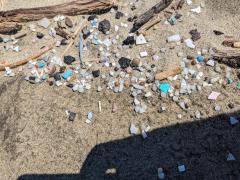Marc Ward, the founder of Sea Turtles Forever, stood on a beach in Costa Rica, surrounded by the tragic sight of 100 sea turtles, dead and filled with microplastics. “I was on a beach where 100 sea turtles were completely filled with microplastics, dead, this is why I do this work,” said Ward.
Sea Turtles Forever, a nonprofit organization, has been devoted to the conservation of marine turtles and the protection of their nesting and foraging habitats since 2002. With operations in Punta Pargos, Costa Rica, the organization has been able to safely conserve and hatch over 11,000 baby sea turtles every year.
But the rise in global plastic production has led to a new threat: microplastics. These small pieces of eroded plastic are the most toxic of all, absorbing high concentrations of PCBs and other harmful chemicals from the ocean. In response, Sea Turtles Forever’s Microplastic Removal Team has developed a static charge filtration screen technology to easily remove microplastic debris from sand.
“Over forty volunteers met at the end of Treasure Cove Lane to work nets, shoveling sand, sifting through the organic debris to pull out the highly toxic microplastics,” Ward described. “The plastics leech heavy metals, polychlorinated biphenyls (PCB’s), and pesticides into the soil and ocean.”
Where does the plastic come from? A variety of sources, including cargo container ship disasters. Ward discovered a handful of nurdles used to make plastic consumer goods, likely from an ocean craft sinking or a container falling off in bad weather. But the majority in volume of the plastics were bits and pieces of post-consumer material. “Bright bits of poison that fill the bellies and organs of all ocean life. Humans, now with more plastic!” he added.
Nurdles, or small plastic pellets about the size of a lentil, are used to manufacture nearly all plastic products. According to the Plastic Soup Foundation, up to 23 billion plastic nurdles end up in the environment every day in the EU alone. The Great Nurdle Hunt estimates that about 230 billion kilos of plastic nurdles enter our seas and oceans every year.
These nurdles can be mistaken for food by marine wildlife like seabirds, fish, and crustaceans. They pose a threat to creatures and habitats for years to come, as they are tiny, persistent, and potentially toxic. Nurdles can get trapped in an animal’s stomach, causing ulceration and leading to starvation and potentially death.
The plastics industry and the issue of nurdle pollution is global. Accidental spills can happen wherever nurdles are handled or transported. When not cleaned up properly, they enter waterways, eventually reaching our oceans. Increasingly, big spills of nurdles at sea are being reported, such as the MV X-Press Pearl spill off the coast of Sri Lanka, the worst environmental disaster in the country’s history.
Sea Turtles Forever’s mantra, “More Turtles. Less Plastic.” is a vision that leads to a healthier ecosystem for all marine life. With the support of volunteers and the community, they are leading a global initiative to clean up beaches worldwide.
Check out the event here: https://youtu.be/eY-iGU6wP9Q


